Behind the plague serum, 187 million bodies lie.
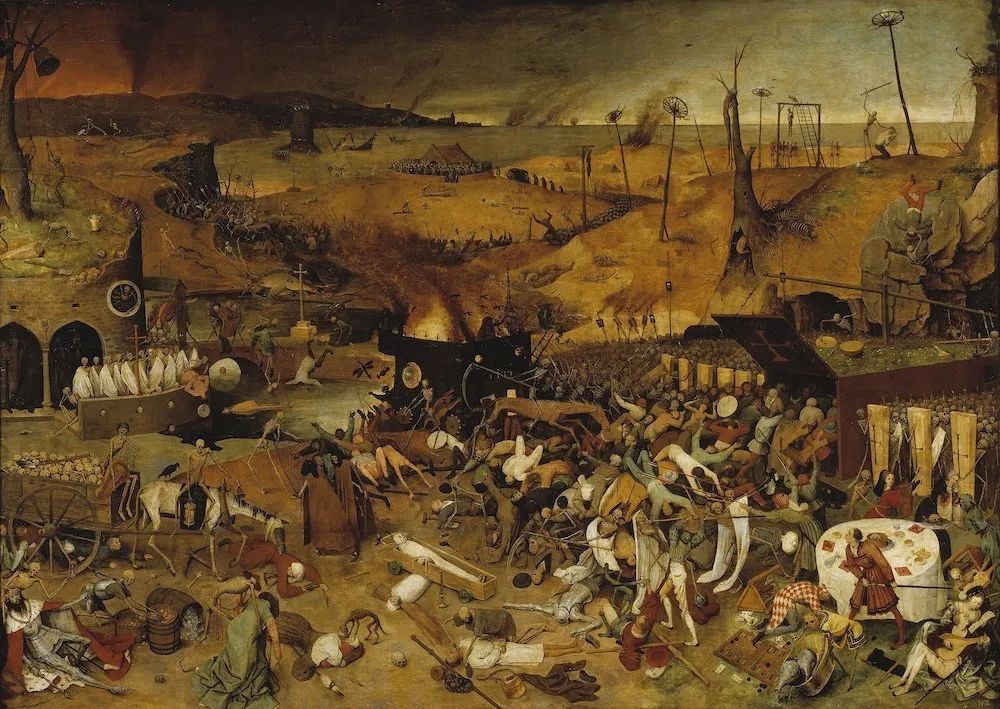 After several months of plague, people can’t catch up with the speed of new bodies, and Constantinople, which was originally prosperous, has almost become an empty city. Many people go crazy before they die, run to the street and dance around, and then die suddenly and fall down. The corpse truck covered the corpse with flowers to cover its odor, and the ashes of burning corpse floated in the air. On July 5, the official micro-signal of Bayannaoer Health and Health Commission issued a notice, saying that the suspected plague cases reported by Urad Zhongqi Hospital on the 4th were diagnosed as bubonic plague cases by the expert group. On July 6, the patient’s condition was stable and life-threatening, and he is currently being treated in isolation in the infectious disease ward. Follow-up investigation of close contacts around it is still in progress. Beijing CDC issued an important reminder to stay away from the grassland, not to eat wild animals, and not to camp in the grassland for the night.
After several months of plague, people can’t catch up with the speed of new bodies, and Constantinople, which was originally prosperous, has almost become an empty city. Many people go crazy before they die, run to the street and dance around, and then die suddenly and fall down. The corpse truck covered the corpse with flowers to cover its odor, and the ashes of burning corpse floated in the air. On July 5, the official micro-signal of Bayannaoer Health and Health Commission issued a notice, saying that the suspected plague cases reported by Urad Zhongqi Hospital on the 4th were diagnosed as bubonic plague cases by the expert group. On July 6, the patient’s condition was stable and life-threatening, and he is currently being treated in isolation in the infectious disease ward. Follow-up investigation of close contacts around it is still in progress. Beijing CDC issued an important reminder to stay away from the grassland, not to eat wild animals, and not to camp in the grassland for the night.
Characteristics and symptoms of plague
Plague is an ancient infectious disease, which is caused by Yersinia pestis. It is a special zoonosis that rodents and fleas transmit Yersinia pestis to humans and animals. It is a Class A infectious disease. The incubation period of plague is generally 1 to 6 days, and individual cases can reach 8 to 9 days. According to different modes of infection, the common plague can be manifested as bubonic plague, pneumonic plague and septicemia plague, and the patients in Bayannaoer this time are bubonic plague. The bubonic plague suddenly developed chills, high fever, headache, fatigue, general aches, nausea, vomiting, restlessness, skin ecchymosis and bleeding. The lymph nodes in the drainage area of rat flea bite were swollen and swollen, which developed rapidly and reached the peak on the 2 nd to 4 th day. Inguinal lymph nodes are most frequently involved, followed by axillary, cervical and submandibular lymph nodes. The route of transmission of plague is a natural focus disease, and the host animals carrying plague bacteria are mainly rodents such as rats and marmots. 1. The transmission of rat flea bites is the main route of transmission, which can spread pathogens (Yersinia pestis) from animals to people, forming a transmission mode of "rodents → fleas → people". 2. The respiratory secretions of patients with respiratory infection contain a large number of Yersinia pestis, which can spread from person to person through respiratory droplets and cause human plague pandemic. 3. Transmission through skin contact. The damaged skin mucosa of healthy people can be infected when it comes into contact with the pus and sputum of patients or the skin and blood of diseased rodents.
Bayannaoer City started the Class III early warning period of plague prevention and control on July 5, and the early warning period will last until the end of 2020. One case, as for letting the whole city "make a mountain out of a molehill" into an alarm state? This is no exaggeration at all. After all, living in modern times, we have never experienced the three "baptisms" of plague in human history, and it is understandable not to understand its horror. These three plagues were called "Justinian Plague", "Black Death" and "Yunnan Plague" by later generations. History cannot be erased, because it really affects human beings too much-according to the statistics and estimates of historians, plague killed at least 180 million people.

Since 542: natural disasters, divine punishment, and nothing can be done.
Patients always think that the end of the world is coming, and self-harm and self-abuse often occur.
In an era when medicine is still completely underdeveloped and even relies on shamans, witch doctors and alchemy to cure diseases, infectious diseases are no different from natural disasters. In 542 AD, the plague broke out in Africa, and then spread all over Europe and West Asia along the Mediterranean trade route. At that time, the scene was like death arrival. The doctor didn’t know what disease it was, where it came from, let alone how to treat it. All people could do was pray.

The symptoms of this great plague mainly include the following: first, patients are mostly manifested as unconsciousness and listlessness. After being affected by the plague, compared with normal people, patients always feel an illusory scene in front of them, always think that the end of the world is coming, and often suffer from self-harm and self-abuse due to this influence. Secondly, the lymph in the patient’s thigh is swollen and presents the appearance of decay. These superficial people tend to have thin thighs, persistent head fever and diarrhea. Third: There are many erythema on the patient’s body. At the beginning of the plague, only some parts of the body showed signs of erythema. After a period of time, the place where erythema had previously appeared began to fester, and finally the patient should die of physical ulceration and mental disorder.
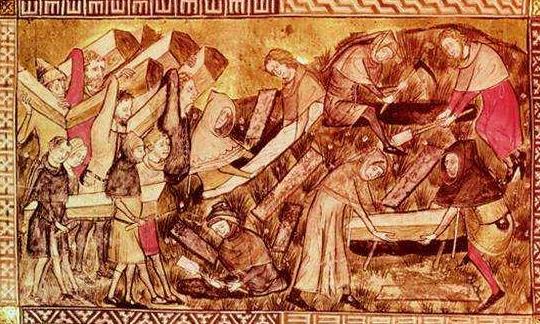
As for the numerous unclaimed dead bodies caused by the plague, the emperor buried them on the spot. Because the number of dead people was too large, it was a very complicated job to bury them. In order to solve the stench of the dead bodies in the city, Justinian also ordered people to dig dozens of huge deep pits in the galata area of Golden Horn Bay to bury the dead bodies. In these pits, in order to keep enough space as much as possible, all the bodies were stacked together in a certain direction and order. It is said that each pit can bury about 70,000 bodies. Although this way of burying corpses may not be an effective measure to control the plague at present, it did play a certain role objectively under the conditions at that time.
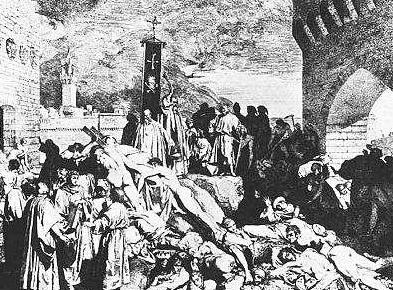
Even the most powerful Eastern Roman Empire at that time lost 14 million people and even the emperor was bedridden. According to historians’ estimates, about 100 million people died in this disaster.

Beginning in 1348: a black nightmare that lasted for more than 70 years.
The plague is pervasive, has no national boundaries, and does not distinguish between races. No country can be exempted.
There is a famous "Church of Human Bone" in Kutnahola, a small town about 70 kilometers east of Prague. The decorations such as candlesticks and chandeliers are all patched together from different parts of human bones, and the scalp of the audience is numb. In Europe, it is not surprising that similar "human bone churches" exist in many cities. Most of these human bones came from the mid-14th century-the Black Death swept across Europe, killing about 25 million people (nearly half of the total population of Europe at that time) in a few years, and even killing people and leaving bones everywhere.

In 1346, a plague broke out in Kafa, a commercial colony of the Republic of Genoa on the Black Sea. Normal people fell down one by one, and the death toll soon exceeded that of the living. The government used wooden poles to push the bodies with nowhere to be buried into the sea nearby, and the port was abandoned. Infected people grow large lumps on their faces, necks, armpits and groins, and their skin appears dark spots. Most of them will die within 48 hours of infection. At that time, people gave this plague an image name-The Black Death.
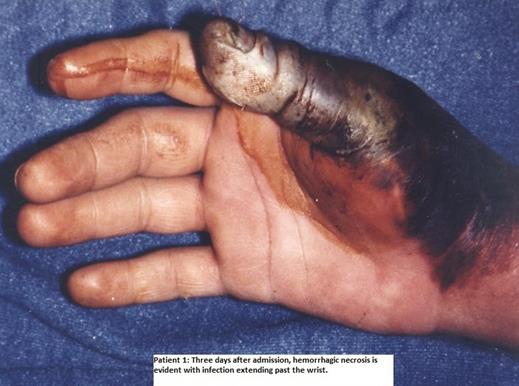
A Genoese went to Piacenza, northern Italy, to visit his relatives and was forbidden to enter the city. At that time, it was raining, and he cried and begged outside the city gate until dark. His relatives really couldn’t bear to secretly open the city gate and take him home for the night. The next morning, the relative went to the streets … A few days later, there was no living person in Piacenza. A few weeks later, the Black Death marched into Milan, Turin, Verona and Florence … The whole of Italy suffered, and Florence was the worst, with 95,000 people in the city dying 55,000 people. "Florence suddenly became a hell on earth: pedestrians walked in the street and suddenly fell to the ground and died; People who stay at home die alone, and no one knows until the body odor is smelled; Every day, a large number of bodies are transported outside the city every hour; Cows wander around the streets of the city, but no one can be seen … "Boccaccio, an Italian writer who is known as the three outstanding figures in medieval literature, experienced the Black Death, which he wrote in his collection of novels decameron. In 1348, the plague soldiers divided into many ways and conquered the whole European continent. Except for the British Isles and Scandinavia, no country was spared. England also failed to survive the spring of 1349. The Black Death suddenly entered the Channel Islands from Calais, and then marched into Great Britain. By May, there were only 30,000 residents left in London. British merchant ships brought the virus to Scandinavia, and even Greenland suffered. People turned pale when they heard the Black Death, and the dark medieval Europe fell into a dark moment. The plague is pervasive, has no national boundaries, regardless of race,No country can be exempted. 
Compared with the first pandemic, medicine in this period not only failed to make progress, but even the sanitary conditions declined because of the war. In the 15th and 16th centuries, the plague tortured human beings for 300 years. The average life span of the population in the epidemic area was only 20 years old, which was not as good as that of primitive people. The European continent lost nearly half of its population.
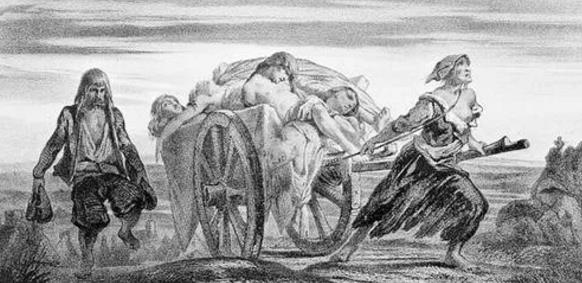
"The usual source of infection is the black rat, sometimes called the old English rat. This animal is closely related to people, and it is a beautiful little guy with black fur. Unlike the brown mouse, it likes to live in houses and boats, rather than in farms and sewers. Being close to people makes it easy for fleas to jump from mice to people, which will also spread plague. This disease, whether it is for rats or people, has a high mortality rate once it is infected. " Frederick F Cartwright and Michael Biddis described it in "Disease Changed History". "Many people with carbuncle and swollen glands have survived, but no one lives vomited blood." This description comes from Karl Lechner’s book The Great German Plague: 1348-1351.
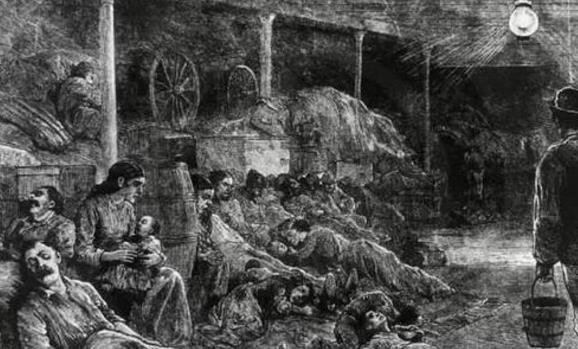
"People who vomited blood died soon. Some people were healthy, but suddenly they vomited blood, and then they died. There is no medicine to cure. " The text is from Piacenza and Parma, written by Dominican friar John Descornes Zano. According to the records of Byzantine emperor John Kantakuzen, there is no cure for this disease. Neither a regular life nor a strong body can resist this disease. Whether you are strong or weak, you will be knocked down by the disease. A well-fed aristocrat is as hard to avoid death as a poor man with nothing. There are no other types of diseases this year, and all diseases are like this epidemic. Medicine is powerless in the face of the epidemic. The process of illness varies from patient to patient. Some patients die suddenly, some patients stay sick for one day, and others only last for one hour. Those whose illness can last for two or three days first have a high fever. Then the disease invaded the brain, and the patient lost his language ability, and he didn’t know anything about what was happening around him. He looked like a deep sleep. If the patient can wake up and want to talk, his tongue can’t move and he can only pronounce a few vague syllables because the patient’s nerves are paralyzed. Here we go. The patient suddenly died. Other patients don’t have symptoms in the head, but their lungs and respiratory organs become inflamed quickly, and they have severe chest pain and vomit blood. The patient’s exhaled breath became foul-smelling, and his throat and tongue became black and congested with high fever. 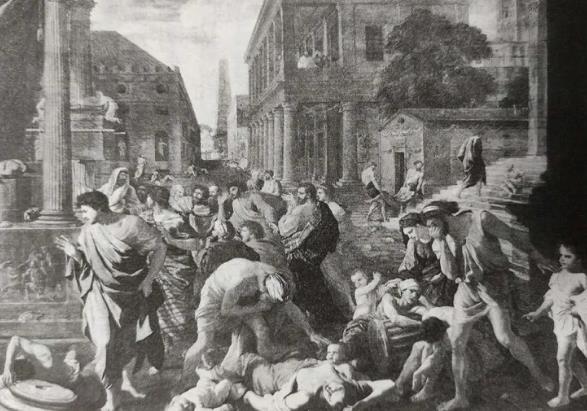
Most people infected with this disease are doomed to death. People don’t know what to do except pray and run away. In extreme fear, people came up with various methods, such as smoking the room, taking a bath with urine, burning lymph nodes and putting dried toads on them … However, none of them worked. The government has introduced many measures, including mandatory reporting, isolating patients, burning the articles of the people who died of the Black Death, and issuing relevant laws prohibiting doctors from leaving infected areas. Plague doctors (who specialize in treating plague patients) can only wear "strange clothes" in order to protect themselves from being infected by "poisonous gas" with viruses. This kind of protective clothing is usually a jumpsuit consisting of a large piece of leather or batik canvas, a large piece of crystal glass and a long beak. The bird’s beak is stuffed with spices (such as camphor, mint, clove and myrrh), dried flowers (such as roses and carnations) and even a sponge stained with vinegar. Because the protective clothing can’t defend against the poisonous gas carrying the virus, the plague doctor can only hope that these articles with strong smell can dilute the poisonous gas.
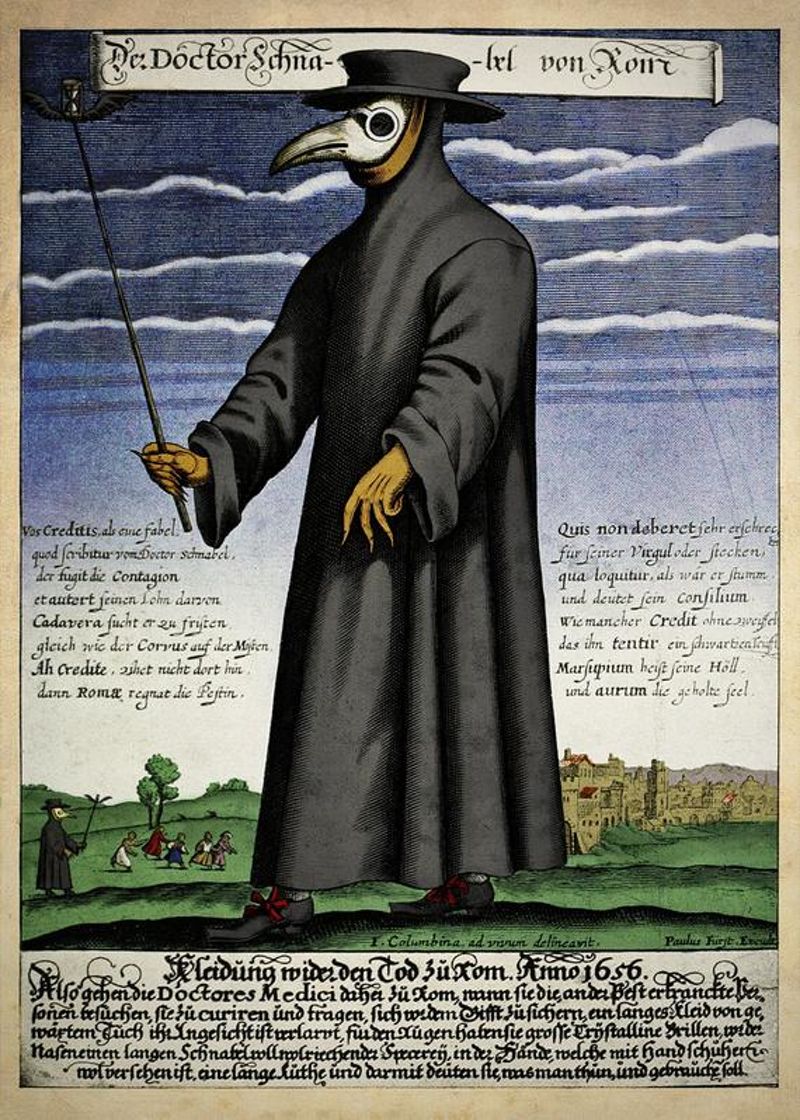
Plague doctors usually carry a cane. According to the scholar G. L. Townsend, this kind of walking stick has a wide range of uses, such as: giving instructions to "ventilate" the patient’s dark house where toads and spiders are crawling everywhere, letting the patient "suck some bottled air", taking a bath with urine, eating laxatives or stimulants; Measure the patient’s pulse, take off the patient’s clothes, and push away patients who are too close to themselves. Plague doctors will sign a contract with the city government, which stipulates that they must wear this protective clothing. If this "humanoid bird" appears at the door, it means that death is not far away.
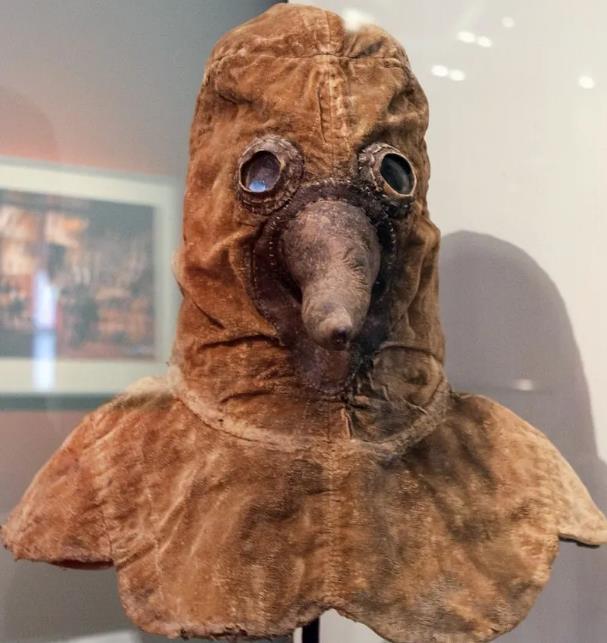
Plague doctors’ headgear in 17th century Germany/Austria. Even if there is a plague doctor in the German History Museum in Berlin, too many people can be infected and die too quickly. The cemetery was no longer enough, so people dug ditches and lined up hundreds of bodies like cargo on a ship. Sprinkle a little soil in the middle of each layer of corpses until the ditch is filled.
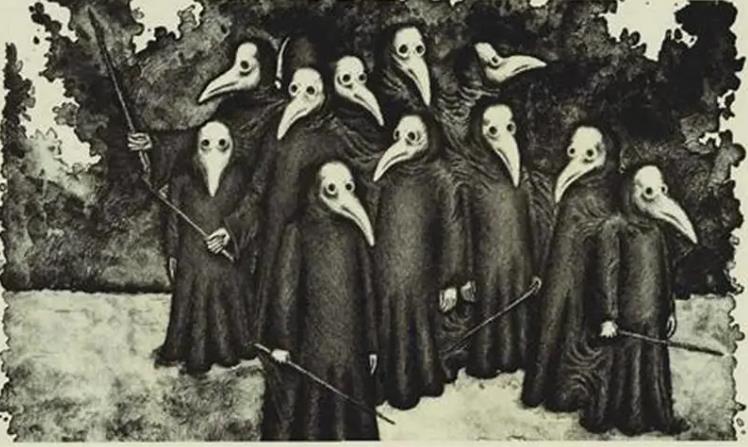
"medical team" Another Italian writer at that time commented: "A father will avoid his seriously ill son, a brother will avoid his sick brother, and a wife will stay away from her sick husband. Healthy people will be very careful to avoid patients. Priests and doctors are even afraid to go near patients. Everyone ran away when they saw the body. " 
In the end, the second epidemic of plague lasted for more than 70 years, spreading to Europe, Asia and Africa, taking a quarter of the population of Europe. It once led to the collapse of European society and entered a state of chaos and disorder. The "Black Death" caused about 75 million deaths worldwide, including more than 25 million deaths in Europe. If we want to say the end of the second plague outbreak in the true sense, it will have to wait until the seventeenth century or even 1800.

Beginning in 1855: The culprit finally appeared.
Control traffic, isolate epidemic areas, cremate bodies, establish hospitals for treatment …
There are different opinions about the origin of this epidemic, but the mainstream thinks it was in Yunnan, China in 1855. Compared with the previous two pandemics, the third plague pandemic has obvious differences: firstly, its spreading speed is faster and its spreading area is far ahead of the previous two times, and it has spread to more than 60 countries in Asia, Europe, America and Africa in several decades; Secondly, although the death toll has reached an astonishing 12 million, compared with the previous two times and the vast scope, the death rate has been significantly reduced. 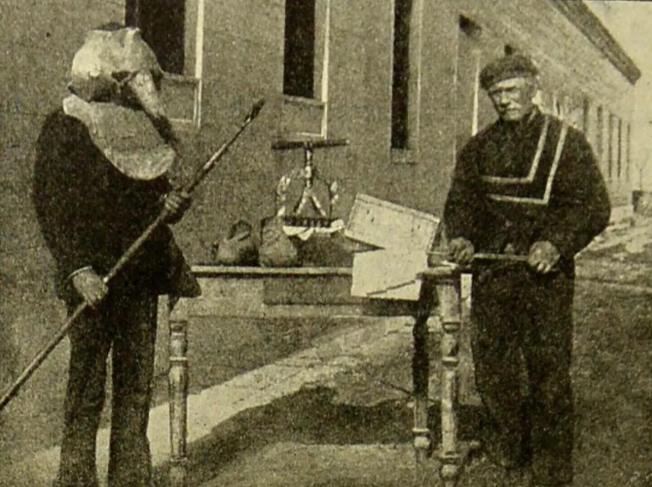
The Man with the Plague Head Cover on Bo Veglia Island (1899) The plague pandemic didn’t end until 1959, and its historical influence dropped obviously compared with the two world wars.
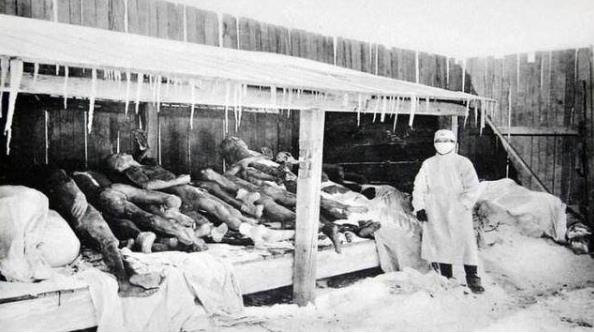
The biggest impact of this plague pandemic was to find the real cause of plague-Yersinia pestis: in 1894, the famous French biologist Yersin successfully discovered the pathogen of plague, and in the following year, he developed the anti-plague serum. Since then, human beings have scientific methods to prevent and treat plague.
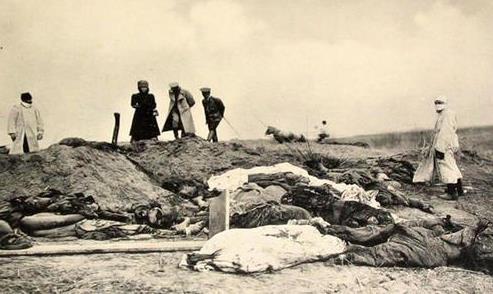
It is worth mentioning that from 1910 to 1911, there was another plague that spread from Russia to the three northeastern provinces. This plague caused more than 60,000 deaths, and at one time there was a tragic situation of "the whole village lost its family and died of serious illness". In order to cope with the spread of plague in the three northeastern provinces, the Qing government immediately set up the "Jingshi Epidemic Prevention Bureau" and set up its inspection office in Shanhaiguan to conduct quarantine in Haikou. In addition, the Qing government also established the "World Plague Research Institute" in Fengtian (today’s Shenyang) at that time, and in 1911, it established the "Plague Research Institute" in Harbin. In these two institutions, Dr. Lien Teh Wu, a famous medical scientist, is the president and director of the research institute.

Lien Teh Wu took effective prevention and control measures such as controlling traffic, isolating epidemic areas, cremating corpses, and establishing hospitals, which made the plague that shocked China and foreign countries under control in less than four months. In recognition of Dr. Lien Teh Wu’s achievements in fighting the plague pandemic, the Qing government also awarded him the rank of Army Blue Ridge and a medical scholar, even known as the "Plague Fighter".
Now, the plague is very rare, but it has not completely disappeared, because it will still spread among rats and mice, and will spread to people whenever possible. In 1980s, plague was reported every year in Africa, Asia and South America. The plague that broke out in India in 1996 also became a major news in the world. At present, about 1000 to 2000 people are infected with plague every year. Even in the United States, on average, more than 10 people are infected with plague from wild rodents every year, and 1/7 patients die. After the founding of New China, the Chinese government attached great importance to the prevention and control of plague, and the number of cases dropped significantly. By the 1980s, an average of about 20 cases were reported every year. In the 1990s, the epidemic situation of plague in southern China rose briefly, and only sporadic cases were reported every year since 2010, mainly in some provinces in northwest China. Not long ago, in November 2019, two cases of pneumonic plague were also confirmed in Beijing. Everything tells us that the plague has never left.
How can the public do personal protection?
Experts remind the general public to do personal protection in strict accordance with the requirements of "three noes and three reports" for plague prevention and control, and to improve their awareness and ability of self-protection.
1. "Three noes": Do not hunt animals with epidemic focus, do not strip animals with epidemic focus, and do not bring animals with epidemic focus and their products out of the epidemic area without permission.
2. "Three Reports": report the discovery of sick (dead) marmots and other animals, report the discovery of suspected plague patients, and report the discovery of unexplained patients with high fever and sudden death. 3, should maintain good personal hygiene habits, try to avoid going to crowded places, go to medical institutions or personal symptoms such as fever, cough should wear a mask in time.
4. If you suspect that you have had contact with the case, you can take the initiative to report to the local disease control department and get professional guidance. Once you have symptoms such as fever, cough, lymph node pain, hemoptysis or bleeding, you should seek medical advice in time.
5. When traveling, minimize contact with wild animals, don’t tease marmots with unknown health, prevent flea bites, avoid being bitten by fleas by using repellent, reduce body exposure, and don’t hunt and eat wild animals without permission.
Plague will constantly change its face and always coexist with the process of human development. Although plague is not an incurable disease and easy to control, the shadow left in people’s hearts by historical tragedies is hard to eliminate, and it is still regarded as the most horrible disease by many people.